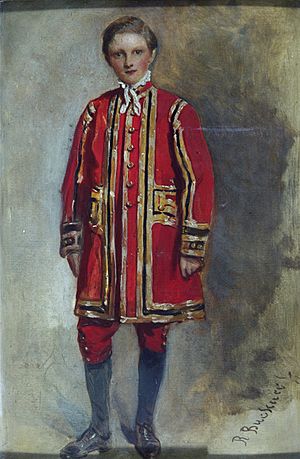Chapel Royal facts for kids
The Chapel Royal is a special part of the monarch's (the King or Queen's) household in the United Kingdom. It is a very old tradition.
Many people use the term "Chapel Royal" to mean the choir. However, the correct name for the choir is the Gentlemen of the Chapel. They are a group of priests and singers who perform church services for the British monarch. Young boy singers, called choristers or Children of the Chapel, help them.
Today, the Chapel Royal uses two special buildings at St James's Palace in London. This palace is close to Buckingham Palace. These chapels are not part of a regular church diocese (a church district). Because of this, they are called "royal peculiars." This means they are "special" and belong directly to the monarch. Services are held every Sunday, except during August and September. The public is welcome to attend these services. This is the only time people can usually enter these royal chapels. The choir also sings at special events. One important service is on January 6th for Epiphany. During this service, gifts of gold, frankincense, and myrrh are offered on behalf of the monarch.
History of the Chapel Royal
The Chapel Royal has a long history, going back to the late 13th century. In those early days, the priests and choir traveled with the king wherever he went.
In the 17th century, the Chapel Royal had its own building in Whitehall. Sadly, this building burned down in 1698. Since 1702, the Chapel Royal has been based at St James's Palace.
During the 16th and 17th centuries, the Chapel Royal choir was considered the best in England. Famous composers like William Byrd and Thomas Tallis were organists there. They worked during the time of Elizabeth I. Sometimes, talented boy choristers from other parts of England were made to join the Children of the Chapel. These boys also performed in plays at the king or queen’s court. King Charles II loved musical instruments. Because of this, the choir often sang with violins, lutes, and viols.
Many very famous composers worked as organists at the Chapel Royal. These include:
- Thomas Tallis (from about 1545 to 1585)
- William Byrd (from about 1572 to 1618)
- John Bull (from 1591 to 1613)
- Orlando Gibbons (from 1605 to 1625)
- John Blow (from 1673 or 1674 to 1708)
- Henry Purcell (from 1682 to 1695)
- Jeremiah Clarke (from 1704 to 1707)
- William Croft (from 1708 to 1727)
- George Frideric Handel (from 1723 to 1759)
When Handel was hired, he was still German, not English. This meant he could not be a full member of the Chapel. So, he was given a special title: "Composer of Musick of His Majesty's Chappel Royal."
The Chapel Royal Today
Today, the Chapel Royal choir practices twice a week at St James's Palace. The choir has six "Gentlemen-in-Ordinary." These are professional singers. There are also ten boys who have special scholarships. They attend the City of London School, where they are known as Queen's Scholars.
Sir Peter Maxwell Davies was the Master of the Queen's Music. He worked closely with the Chapel Royal. He wanted to write a new carol for them every Christmas.
The Chapel Royal also has a branch in Scotland. Its head is called a Dean. There was once another Chapel Royal in Ireland.
Images for kids
-
George, Duke of York and Mary of Teck at the Chapel Royal in St James's Palace, 1894
-
Entrance to the Chapel Royal at Hampton Court Palace
-
Christ Church Royal Chapel is one of three Chapels Royal in Canada
-
Prince Arthur at Mohawk Chapel in 1913. This church became a Chapel Royal in 1904.
See also
 In Spanish: Chapel Royal para niños
In Spanish: Chapel Royal para niños






